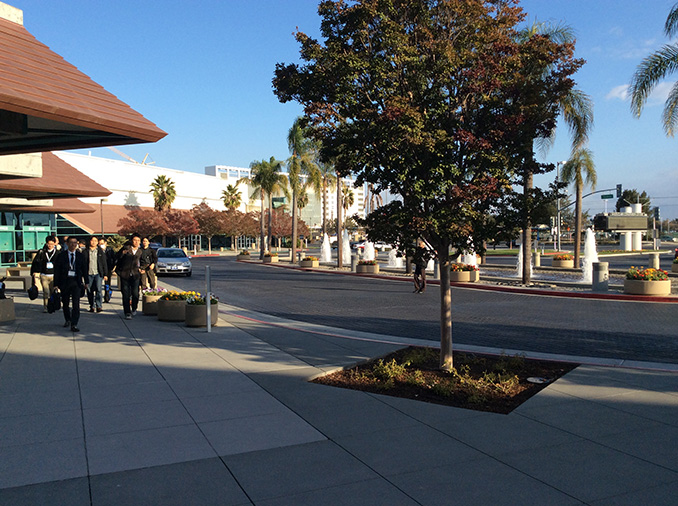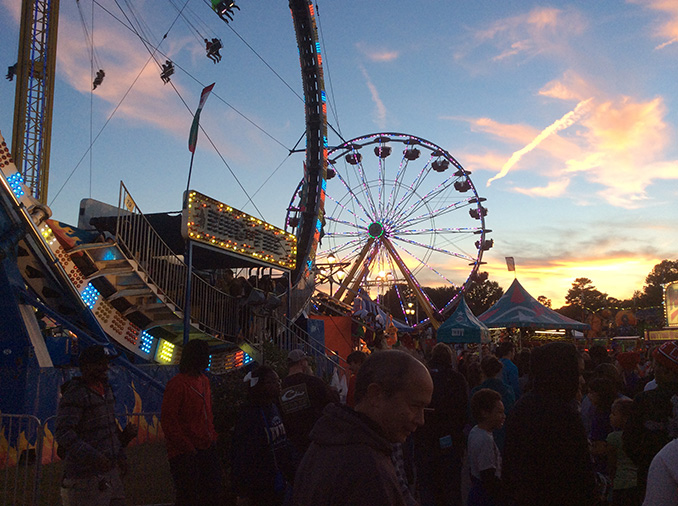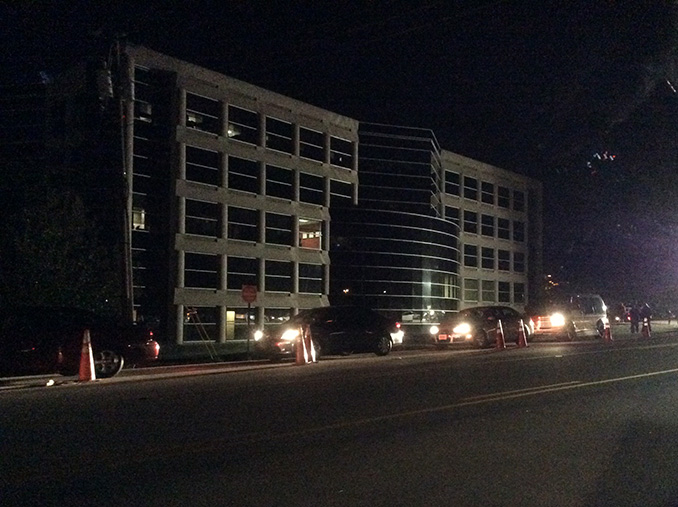The iPad Air Review
by Anand Lal Shimpi on October 29, 2013 9:00 PM ESTCamera
Front and rear facing cameras are necessary features on all modern, premium tablets. The usage model for a rear facing camera on a tablet is hopefully not as a primary image capture device but rather a convenient one. The idea being that if you’re on location somewhere using the iPad for work or play and need to quickly grab an image, having a decent rear facing camera can come in handy rather than having to put away your tablet, pull out your phone and then switch back afterwards.
Apple has improved its iPad imaging systems almost every single generation. That being said, the iPad Air is a bit of an exception to the rule as it retains the same rear camera sensor as the 4th generation iPad. We’re still talking about a 5MP sensor with f/2.4 lens, although the iPad Air now has a wider field of view with a 3.3mm focal length (identical to the original iPad mini).
| Rear Facing Camera Comparison | |||||||
| Sensor | Resolution | Aperture | Focal Length | ||||
| Apple iPad Air | 5MP | 2592 x 1936 | f/2.4 | 3.3mm | |||
| Apple iPad 4 | 5MP | 2592 x 1936 | f/2.4 | 4.3mm | |||
| Apple iPad 3 | 5MP | 2592 x 1936 | f/2.4 | 4.3mm | |||
| Apple iPad 2,4 | 0.7MP | 960 x 720 | f/2.4 | 2.0mm | |||
| Apple iPad mini | 5MP | 2592 x 1936 | f/2.4 | 3.3mm | |||
The rear facing camera tends to shoot at lower ISOs than the rear camera on the iPad 4. Since there’s no substantial change in the sensor or lens system however, the result is less noise but a darker image in low light situations. I suspect this might be more of a configuration default for the software layer driving the H6 ISP in Apple’s A7. Image quality is surprisingly good:
Even lower light shots come out fairly well:
Although obviously noise goes up appreciably once you get into really dark scenes:
I took a bunch of photos at the NC State Fair as well as on my trip out to Santa Clara following the iPad launch event in the gallery below.
Despite using the same ISP as the iPhone 5s, there’s no 10 fps burst capture mode on the iPad Air. Similarly there’s no slo-mo video recording mode either. The iPad Air does inherit the other benefits of the new H6 ISP however. Image capture is still insanely quick, which makes me wonder if the A7’s ISP also leverages that large on-die system cache.
| Front Facing Camera Comparison | |||||||
| Sensor | Resolution | Aperture | Focal Length | ||||
| Apple iPad Air | 1.2MP | 1280 x 960 | f/2.4 | 2.15mm | |||
| Apple iPad 4 | 1.2MP | 1280 x 960 | f/2.4 | 2.18mm | |||
| Apple iPad 3 | 0.3MP | 640 x 480 | f/2.4 | 1.8mm | |||
| Apple iPad 2,4 | 0.3MP | 640 x 480 | f/2.4 | 1.8mm | |||
| Apple iPad mini | 1.2MP | 1280 x 960 | f/2.4 | 2.2mm | |||
The front facing camera does see an improvement in sensitivity thanks to a larger sensor format. My understanding is this is the same sensor/lens combination as what’s in the iPhone 5s and 5c. Similarly to its implementation in the 5s, Apple seems to use the new front facing camera system to drive to lower ISOs and/or higher shutter speeds. You typically end up with a lower noise/sharper image, although sometimes there is a brightness/exposure tradeoff.
The other feature leveraged by the new front facing camera is the inclusion of a second microphone for noise cancellation. The goal here is to use the second mic to cancel out background noise and improve the quality of the audio you’re actually trying to record (presumably your voice during FaceTime for example). The impact is pretty noticeable. I ran an iPad 4 and an iPad Air side by side while playing a background track and have embedded the resulting videos below:
In the iPad Air sample video my voice comes across considerably clearer, as you’d expect given the Air’s second mic.
Video
Video capture settings look unchanged from the iPad 4. We’re still dealing with ~17Mbps High Profile videos from the rear camera and ~10Mbps Baseline Profile H.264 from the front camera.
Video quality out of both is pretty good for a tablet. In well lit scenes rear camera quality is definitely sufficient for sharing on the web.




















444 Comments
View All Comments
doobydoo - Friday, November 15, 2013 - link
The hardware in the HDX is slower, and it is finished in plastic. So which part was inaccurate?melgross - Wednesday, October 30, 2013 - link
There is no such thing as 100% RGB gamut. Which gamut are you talking about? sRGB? Adobe 1998 RGB? Pro RGB? There are a lot of RGB standards out there.Theard - Wednesday, October 30, 2013 - link
what Cindy implied I didn't even know that people can earn $6894 in four weeks on the computer. look at this site ... jobs23.comLizbeth - Sunday, November 3, 2013 - link
and is several price points less that the ipad airKrysto - Wednesday, October 30, 2013 - link
> is probably the higher clocked Z3770I don't see that in any tablets today, let alone smartphones. So don't say it like that, as if it's already happened. As it is, Intel's chips aren't very competitive, in both CPU and GPU performance.
> while Qualcomm will probably pass Apple's GPU early next year.
They are equal right now, at least in smartphones. The others, perhaps with the exception of Nvidia, don't really make separate "tablet chips". They make one chip for both smartphones and tablets.
Speedfriend - Wednesday, October 30, 2013 - link
"As it is, Intel's chips aren't very competitive, in both CPU"You obviously have a problem reading, given the Transformer T100 which is very close to the iPhone 5S and iPad Air in the benchmarks above, uses the Atom Z3740, which is only the second fastest. So the Z3770, which is clocked 33% higher, should be at least equal if not better than A7 in CPU benchmarks.
How in your mind that equates to not competitive I don't know..
Homeles - Wednesday, October 30, 2013 - link
Not to mention that a lot of A7's strength isn't in the silicon, it's in the software stack on top of it. All of the CPU benchmarks are done through the stock web browser -- that's something Apple can fine tune, while Intel cannot. Therefore, the A7 outperforming Atom doesn't point to Atom being weaker at a silicon level, and instead shows the advantages of being able to hand tune your OS and applications and squeeze more out of your hardware.raptorious - Wednesday, October 30, 2013 - link
I'll give you one reason: the fact that Anand omitted the iPad 4 from the latency graph in the "An Update on Apple’s A7: It's Better Than I Thought" page. Why is the iPad 4 in the bandwidth graph and not in the latency graph. I'll tell you why: because the iPad 4 has better latency and Anand doesn't want to make the A7 look bad, so he left it out. No bias? Right.syedjalalt - Tuesday, November 5, 2013 - link
Apple iPad is a great product. No doubt. The word selection for writing such important reviews has been good here. IF you go The Verge and see the iPad review, you will notice how biased and predictable they have become. Nilay Patel doesn't know anything. The guys @verge always mock Android and especially Samsung.Last year's Nexus 4's review score had 8 for camera and 9 for ecosystem(as far as I remember). This year, ecosystem is 8 and camera is 5. Great!!!1
doobydoo - Friday, November 15, 2013 - link
Yep it's ridiculous that the Nexus 4 got 8 for camera. Should have been 3/4.Ecosystem scores can vary over time so don't see the problem there. Android hasn't moved on much in the past year.